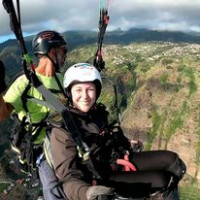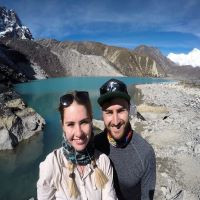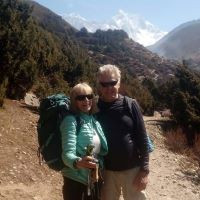Why should I visit Nepal?
Nepal, a country nestled in the heart of the Himalayan mountain range, is renowned for its rich history and ancient culture. It is a must-visit destination for any traveler seeking a blend of nature, culture, and warm hospitality. Nepal boasts diverse landscapes, from the plains of the Terai to the lofty peaks of Mount Everest, offering visitors a plethora of options to choose from. Trekkers can revel in the stunning mountain scenery, while those seeking cultural enrichment can explore world heritage sites and immerse themselves in the arts, history, and civilization of Nepal. Additionally, adventure enthusiasts can partake in adrenaline-pumping activities such as white-water rafting, mountain climbing, mountain biking, and bungee jumping. The country also houses a diverse range of flora and fauna, including endangered species such as tigers and rhinos, making it an ideal destination for wildlife lovers. The affordability of Nepal, combined with its friendly locals and delectable cuisine, makes it an unmissable destination for any traveler.
What is trekking in Nepal?
Trekking in Nepal refers to a journey on foot to the Himalayan regions of Nepal, where trekkers can enjoy the natural beauty, diverse culture, and stunning landscapes of the region. This popular trekking activity allows travelers to immerse themselves in the unique culture and environment while exploring the lifestyle of mountain people. There are various trekking routes in Nepal, ranging from easy to challenging that pass from the dense forests, rivers, and farmlands over the high hills of central Nepal.
Is it safe to go trekking in Nepal?
Trekking in Nepal is generally safe, and we can attest to this based on our years of experience in organizing trekking trips in the country. Nepal is a peace-loving country with no religious extremists or radical groups, making it a suitable and favorable destination for travelers from all over the world. The friendly and hospitable nature of Nepalese people, coupled with their religious engagement and natural kindness, creates a calm and peaceful environment for visitors to enjoy.
What are the most popular trekking routes in Nepal?
Nepal offers a diverse range of trekking routes, each with its unique features and attractions. The most popular trekking routes in Nepal include the Everest Base Camp Trek, which takes trekkers to the base camp of the world's highest mountain, and the Annapurna Circuit Trek, which is known for its varied terrain and spectacular scenery. Other popular routes include the Langtang Valley Trek, the Annapurna Base Camp Trek, the Manaslu Circuit Trek, Tsum Valley Terk, and the Upper Mustang Trek. Each of these routes offers trekkers a different experience, from stunning mountain views to cultural immersion in remote mountain villages. Whether you're a first-time trekker or an experienced one, Nepal has something for everyone.
How difficult are the trekking routes in Nepal?
The difficulty level of trekking routes in Nepal varies depending on the specific route and the individual's fitness level and experience. Some routes are relatively easy and suitable for beginners, such as the Ghorepani Poon Hill Trek and the Langtang Valley Trek, while others are more challenging and require a higher level of fitness and experience, such as the Everest Base Camp Trek and the Annapurna Circuit Trek. High altitude and rugged terrain can also add to the difficulty of some treks. It is essential to choose a trek that is appropriate for your fitness level and experience and to prepare adequately by engaging in physical training and acclimatization before embarking on a trek.
What is the best time of year to go trekking in Nepal?
The optimal time of the year to embark on a trek in Nepal is dependent on various factors such as the region you intend to explore, the altitude, and the purpose of your journey. Typically, the most favorable period to go trekking in Nepal is during the autumn months, from early September to late November, and the spring season, from March to May. These months offer the most stable weather conditions with moderate temperatures, clear skies, and relatively low precipitation. Nonetheless, some higher altitude treks might have shorter trekking seasons, while monsoon conditions and the winter season can pose risks and challenges, making it necessary to prepare adequately before embarking on your adventure.
How much is the best duration for trekking in Nepal?
The best duration of trekking in Nepal depends on the trekking route and your personal preference. Some trekking routes can be completed in a few days, while others can take several weeks. For example, the Everest Base Camp trek takes around 12-14 days, while the Annapurna Circuit trek takes around 18-21 days. It is important to consider the altitude and the physical demands of the trek when deciding on the duration. It is recommended to allow some extra days for acclimatization and rest, especially when trekking at high altitudes. Our travel experts can help you design a customized itinerary based on your preferences and budget to ensure that you have an unforgettable experience in Nepal.
Do I need a visa to enter Nepal for trekking or touring purposes?
Yes, visitors require a visa to enter Nepal for trekking or touring purposes. The type of visa you need will depend on the length and purpose of your stay. Tourist visas are the most common type and are available on arrival at the airport in Kathmandu or at border crossings. However, some visitors may require a different type of visa, such as a business visa or a student visa. It may take between 20 minutes to an hour depending on the throng to get a visa card. It is important to check the visa requirements before traveling to Nepal, as regulations can change. Visitors should also ensure that their passport is valid for at least six months from the date of entry into Nepal.
What is the cost of a visa in Nepal?
The cost of a visa in Nepal depends on the type and duration of the visa. For a 15-day multiple-entry tourist visa, the cost is USD 30, for a 30-day multiple-entry tourist visa, it is USD 50, and for a 90-day multiple-entry tourist visa, it is USD 125. Other types of visas for study, business, or work may have different costs and requirements. To know more, click here.
Can I do trekking in Nepal alone?
No, it is not possible to trek in Nepal alone, and also not recommended. As of April 1st, 2023, it is mandatory for all visitors to hire a guide or book their trip with a travel company while trekking in Nepal. Trekking alone in Nepal can be dangerous, especially at higher elevations where altitude sickness and harsh weather conditions can pose a significant risk to one's safety. Prioritizing your safety while trekking in Nepal should always be the top priority. Therefore, it is highly recommended to hire an experienced guide or trek with a group to ensure a safe and enjoyable trekking experience in Nepal. Hiring a local guide can also provide a unique cultural and historical experience of the region while also supporting the local economy.
What is the best way to plan a trekking or touring trip in Nepal?
Planning a trekking or touring trip in Nepal can be overwhelming, but with careful planning and research, you can make the most of your trip. The best way to plan a trekking or touring trip in Nepal is to first determine your budget, the duration of the trip, and your visit interest areas. Then, research the trekking and touring options available in Nepal, including the difficulty level, the duration, the best time to go, and the required permits. You can send your queries to us or go through our blogs and articles and gather information from the Nepal Tourism Board to ensure that your trip is well-planned and enjoyable.
What kind of equipment do I need for trekking in Nepal?
Trekking in Nepal requires proper equipment to ensure your safety and comfort in the rugged terrain of mountains. we have enlisted all gear that is necessary during trekking in Nepal in our Equipment list. For more information about Gear and Equipment, Click Here.
Do I need to have my travel insurance?
Yes, you need to have your travel insurance to tour Nepal. For more about your insurance queries, you can have a look at our Terms and Condition.
What do you do in case of a medical emergency?
As in the trip, our guides and his team are always ready with the first aid kit with all medicines required in the mountain region trek. Considering the medical situation you will get good medication and counseling throughout the trip. In case of emergency, you will be rescued immediately to a lower elevation.
How much will be our oxygen level every day in the mountains?
Our guides always carry an oxy meter along with the first aid kit, so you can measure your oxygen level every day.
Can I use my credit cards on the Trails?
Mostly, credit cards can be used in Kathmandu and some limited shops in Namche Bazzar. Moreover, a 13% fee is charged for credit card payments so it is better to offer cash for your payments during the trek.
How much spending do I have to do each day on the trail?
Usually, it depends on your spending habits. Products in the high altitude are more expensive than in city areas so if you want to buy anything from the local market will cost slightly higher. Besides that breakfast, lunch, and dinner during the trek are included in the packages, and if you want to buy other stuff like snacks, chocolates hot drinks, or any other beverages then you have to buy on your own. Roughly saying, based on our prior experiences people usually spends 2500- 3000 NPR a day on the trip.
Can I charge my electronic gadgets whilst trekking?
Electricity is available to charge your phone, cameras, PCs, and other electronic devices. However, you need to pay some extra cost to charge your phone and devices. Not all lodges and teahouses will charge you extra cost for using electricity. So, it is better to discuss the cost with the owner or you may consult your guide before using the services.
Is a shower available in the hotels we stay overnight?
Hot shower is almost available in tea houses or lodges during the trek. Somewhere hot bucket shower is available rather than a hot tap shower in that case one needs to bath unconventionally. Also ascending to high altitude may lack hot water facilities mainly in the colder season.
Moreover, during the peak trekking season, it is quite challenging to get hot shower facilities due to high demand. All the lodges and teahouses will charge you a certain amount depending upon the season and altitude.
Is laundry service available in the mountain region?
Yes, laundry service is available for you until you pass Namche bazzar. It is difficult to get this service once you walk past Namche Bazzar so you have to wash your clothes manually beyond that. In such case, we recommend you take some extra pairs of clothes during the trip. And if you are uncomfortable washing your cloth on your own then you can pack them separately and get laundry service once you return to Namche Bazzar or Kathmandu.
What about restrooms during the trail?
You can use the restrooms of the teahouses along the way on the trip. In case if teahouse is far away and you feel urgent you can easily find some private place thereof.
Can we surf the internet in the high-altitude zone?
Yes, you will get the facility of Wi-Fi during the trek. Though, Wi-Fi is not available while trekking in the daytime, you can enjoy the internet at the teahouses and lodges where you stay overnight. But again you have to pay some extra cost as Wi-Fi charge which may vary with the altitude we attain.
And for the daytime or the trekking duration, you can get internet data packages using a local SIM card which you can buy in Kathmandu/Namche.
Can we buy/have coffee or tea and stuff like chocolates while trekking?
Yes, you can buy chocolates and other hot drinks in between the way while trekking. There are plenty of teahouses on the way operated by the local community people so that any visitor could take some rest and enjoy little moments with the people there. This will also help people run their businesses.
Is it possible to add extra days to my trip?
Of course, it is possible to add extra days to your trip if you are having your private trip. But if you are joining a group trek, then it is not possible to add additional days to your trip.
Is there any alternative way to Lukla, if the flight is delayed or missed?
The weather here is quite unpredictable due to which flights are not available after midday. Flying to Lukla on another flight/next day flight is the best option in case your flight is missed or delayed. Other than this, using a helicopter/chopper to reach Lukla could be an alternative if you don’t want to wait until another flight which may cost approx. USD 500.00 on sharing basis.
Where can I buy essential gear for my trip?
When you land in Kathmandu, the next day is your acclimatization day. That day you can visit the market over there and buy all the essential gear for you. Or you can also buy them in Lukla or Namche itself, but the price will be higher than in Kathmandu because of their remoteness. You can ask your guide and enlist things that are necessary during trekking in mountains, if you are not experienced or a beginner.
Should I also bring toilet paper?
That is recommended. But, you can also buy it here, both in Kathmandu and on the trekking routes. But the price goes higher with the altitude you attain because of its transportation cost.
What would be the minimum temperature during our trip?
The temperature of the high-altitude region is mostly affected by different factors. It varies in different seasons like the months. Specifically talking about Everest Base Camp, the temperature goes around 1 to 0°C in September to the scale of beyond 0 in December. Except in the winter season, the temperature scale lies around 0°C. However, trekking will keep us warm throughout the trail and mostly we reach base camp at midday which is relatively warmer than dawn and dusk.
What if I need to take a day's rest?
If you are on a private trip, you can customize your itinerary and take a day's rest if you feel so. And, if you join a group then we have to arrange one representative that could be one of our porters who will stay behind with you. Then, you can easily continue the trip the next day provided that you must have a day extra before your international flight.
Do we need extra days for acclimatization?
It is necessary to acclimatize when you are trekking to a height above 4000m. Mainly, there are 2 days of acclimatization when you target to reach EBC. The first day of acclimatization will be on Namche Bazzar where we stay for two nights before we ascend our journey uphill. And the second day of acclimatization will be on Dingboche which is at an altitude of 4410m above sea level.
Can I skip the days of acclimatization?
It is not considered that good to skip the days of acclimatization. However, if you are fit and have been to mountains several times before then acclimatization day could be skipped. But again, you can only skip those days, if you are a regular visitor of high altitudes mountains and healthy enough to keep yourself away from mountain sickness.
May I know about guides?
Our all guides are professional and experienced and are certified by the Nepal Academy of Tourism and Hotel Management. They have several years of trekking experience in the different mountainous regions of Nepal. They all can communicate with you in the English language so it will be very comfortable for you to trek with our guides.
Do I need porters?
The necessity of a porter usually depends on you and your packages. If you are for a short trek and can carry all your gear then you do not need any porter but for a long trek, porters are essential. As for long treks, all your clothing and gear will be more which would be hard for you to carry in high altitudes.
Usually, porters will be moving ahead of you and you can use your things once you reach your destination of the day. So carrying your most needed things for the day in small bags throughout the trip is good. Other than this, porters here would be more than happy if you make them a business.
Can I leave my extra luggage in Kathmandu?
Yes, you can leave extra luggage at the hotel in Kathmandu and take only the most needed and limited with you on the trip. Your luggage will be safe there and you can collect it once you return from the trek.
How much weight is allowed on the Lukla flight?
The weight limit for the Lukla flight is 15kg/33lbs, including both the duffel pack and daypack. Your duffel pack should be around 10kg/22lbs and a day pack around 5kg/11lbs. If your bag pack exceeds the weight limit, you must pay USD 2-5 for each extra kilo at the air terminal. So it is good to keep baggage as light as possible.
What about COVID-19 protocols there?
A downward trend has shown that COVID-19 has fallen globally in the past few months. And the Government of Nepal has amended the entry protocols for all visitors who want to visit this country. All COVID-19 regulations have now been updated and previously issued notices and protocols are nullified now.
A fully vaccinated visitor need not have to submit a negative COVID-19 test report to enter Nepal. But, s/he is obliged to submit the vaccination card against COVID-19. Also, travelers must be vaccinated 14 days before traveling to Nepal.
Similarly, the case of non-vaccinated or visitors who cannot submit their full vaccination certificate will have to show a negative COVID-19 test (RT-PCR, True NAAT, and GENE Xpert) within the last 72 hours before check-in time.
Note: Visitors who submit negative COVID-19 test reports and are fully vaccinated are no longer obliged to stay in quarantine for even a day.




